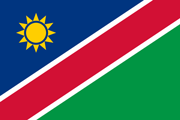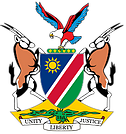About Namibia
Official Name: Republic of Namibia
Capital: Windhoek
Official Language: English
Government Republic: Multi-party constitutional democracy
President: His Excellency Nangolo Mbumba (Since February 2024)
Prime Minister: Dr Saara Kuugongelwa-Amadhila
Independence: 21 March 1990
Population: 2.6 Million (est.2018)
GDP: US$ 10.30 billion
GDP per Capita: US$ 5200
Currency: Namibian Dollar (N$)
Time Zone: GMT + 2h00
Dialing Code: + 264
Internet au: .na
MORE INFORMATION ABOUT NAMIBIA
Located on the west coast of Southern Africa between South Africa in the South, Botswana in the East and Angola and Zambia in the north, Namibia is distinguished by the Namib Desert along its Atlantic Ocean Coast. The capital Windhoek and coastal town Swakupmund contain colonial era buildings such as Christuskirche built in 1907.
Famous for the highest dunes in the world at Sossusvlei and for Etosha National Park, one of the world’s greatest conservation areas, the deepest canyon in Africa, wide open spaces with spectacular landscape, abundant wildlife resources, diversity of experiences, Namibia is one of the most fascinating and diverse countries in the world and a number 1 travel destination — a must see for the world travellor. Visitors are engulfed by a sheer sense of freedom generated by wide and breathtaking horizons, the bluest of skies and a population density which ranks among the lowest in the world, experiencing the serenity you may feel like you are the only person on the planet. Namibia’s capital, Windhoek has been noted many a time as the cleanest city on the African Continent. Namibia was one of the first countries in the world to include the protection of the environment and sustainable utilization of wildlife in its constitution. About 15.5% of the country has been set aside as natural parks, in these areas, rare and endangered species of animals, birds and plant life are preserved and protected.
Both Windhoek and coastal town Swakupmund contain colonial era buildings. Tourism is becoming an increasingly important source of revenue and employment for Namibia.
Already an African Reference with the fast-growing pace of its economy and a strong political stability sustained by a flourishing democracy, Namibia is the fourth largest mineral exporter in Africa and has one of the longest established mining industries on the continent, which brings in more than 50 per cent of foreign exchange earnings. Diamond is the most important source of revenue, but uranium, copper, lead, zinc and magnesium are equally relevant to the industry. Livestock (cattle, sheep and ostriches) represents the majority of commercial agricultural production. Its marine resources are among the richest in the world due to the Benguela Cold Current, which creates an especially beneficial ecosystem with varying weather conditions throughout the year allowing for commercial exploitation of a variety of fish, including sardines, anchovies, mackerel, tuna and hake along with lobster and crabs.
Namibia is a gem worth investing in. With an attractive tax system, an efficient public administration, Namibia has a mature civil society, rich cultural traditions and a strong potential for international investment.
Automobile giant Peugeot has launched a modern assembly plant in Walvis Bay in 2018.
Namibia is ready for business and looks forward to entering into a win-win partnerships with all prospective investors.

